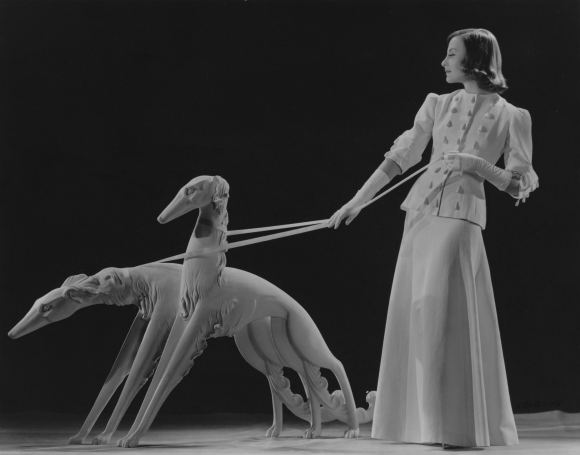
photographed by Ernest Bachrach for RKO. Courtesy of the Hood Museum
This artistic shot is one of the five photographs that I was shown on January 7. This
is a “vintage” gelatin silver print (struck from the negative contemporaneous to its
creation in 1940) that has a marvelous B&W grading.
On the 19th of this month, the Hood Museum of Art will unveil an exciting new exhibit, devoted to showcasing studio photographs from the Golden Age of Hollywood. These photographs only recently came into the Hood’s possession, when it purchased a substantial collection of historical prints from the John Kobal Foundation. The collection itself is immense, totaling over 6,000 individual photographs. These will ultimately be digitized and become available for private viewing once the collection has been fully catalogued. In the meantime, the Hood Museum has selected a representative 22 to be displayed in the forthcoming exhibit. On Monday, February 7, the Hood’s administration was so kind as to afford me an advanced look at five of the photographs that will be featured. Additionally, Associate Curator of American Art Michael Hartman and Registrar Lauren Silverson graciously provided me with information, much of which follows, about the exhibit and the collection from which it is derived.
The late film historian John Kobal began collecting original film photographs in the 1960s. The assemblage of these photographs, which had been commissioned and circulated by the studios in order to promote their films and stars, remained a passion for Kobal until his death in 1991. Kobal’s eponymous foundation was created upon his death to continue the work to which he had long devoted himself: ensuring the preservation and broad availability of these photographs for both historical study and artistic appreciation.
The photographs in the Hood’s acquired collection come from a multitude of sources to which Kobal would often turn and are therefore in several forms. The bulk of the collection consists of original, “vintage” gelatin silver prints—renowned for their smooth, even image surface—which Kobal obtained from studio offices and depositories that had no further use for them. Other photographs in the collection are more recent prints that were struck from negatives which Kobal found, in the absence of vintage prints. In some of these instances, the collection’s photographs are therefore platinum prints, a newer process that ensures a longer lifespan before degradation. In most such instances, however, Kobal was able to secure the services of the original photographer to conduct the same gelatin silver process that had been employed decades earlier. (Kobal also interviewed many of these photographers about their techniques and interactions with their subjects, from which there emerged a wealth of information beneficial to academics and historians.)
While the Kobal Foundation is devoted in no small measure to the archiving and preservation of its holdings, the Hood Museum’s interest in its recent 6,000-piece acquisition lies predominantly in the artistry and history offered by the photographs. To this end, the Hood’s presentation of 22 works in its upcoming exhibit is far more artistically and historically oriented than it is documentarian in nature.
The exhibit will be located within and just exterior to the Hood’s Class of 1967 Gallery, and it shall be divided into two sections. The exhibit’s first section, accounting for roughly two thirds of the works to be displayed, will consist of portraits of film stars. These portraits are undoubtedly significant in that they suggest the inner workings of the studio system and its ever-involved publicity department (which would widely circulate these images to the press, in seeking to cultivate a thorough public persona for a star). However, these portraits are also significant in that they demonstrate the skill and creativity of studio photographers, who played an integral role in shaping stars’ signature looks. For instance, Clarence Sinclair Bull, the head of MGM’s stills department, became particularly renowned as Greta Garbo’s portraitist—although he was also responsible for photographing many other MGM contract stars. Bull is well represented in the exhibit (in which there will be at least one of his Garbo portraits) and the collection at large, as are the celebrated photographers Ernest Bachrach (RKO) and George Hurrell (MGM). Another featured photographer, Ruth Harriet Louise (MGM), is historically notable as the first female photographer active in Hollywood.
The exhibit’s second, less expansive (but still fascinating) section will consist of film stills and photographs taken on film sets. The former were typically shot during breaks in filming, whereupon actors would pose—as if in the midst of acting in a scene—for an expressly designated “still photographer.” Other photographs seem to actually show filming in progress, such as one which depicts Myrna Loy and Spencer Tracy amidst studio lights and a boom microphone in Whipsaw (1935) [a gelatin silver print, struck from the negative in 1981]. Studio photographer Ted Allan likely requested a pause in the action in order to take this shot.
Some of the stars whose photographs, whether portraits, stills, or on-set shots, will be featured include: Fred Astaire, Ingrid Bergman, Marlon Brando, Louise Brooks, Ronald Colman, Gary Cooper, Bette Davis, Dolores del Rio, Greta Garbo, Katharine Hepburn, Rock Hudson, Buster Keaton, Carole Lombard, Myrna Loy, Nina Mae McKinney, Marilyn Monroe, Michèle Morgan, Raymon Novarro, Ginger Rogers, Spencer Tracy, Johnny Weissmuller, and Anna May Wong.
I strongly encourage a visit to the Hood Museum to view these photographs during the exhibit’s run from February 19 through May 21. While this 22-piece exhibit is representative of the broader collection and thus ranges from 1922 to 1961, photographs from the 1920s and 1930s are particularly well represented. This fact renders the exhibit all the more fascinating, in that one can garner a profound appreciation for the artistry intrinsic to this side of the film industry even in its (relatively) early years.
Note: This article appears in the print edition of February 10 under the title “Hollywood Photos at Hood Museum.”

Be the first to comment on "Photographs from Hollywood’s Golden Age: The John Kobal Foundation Collection"